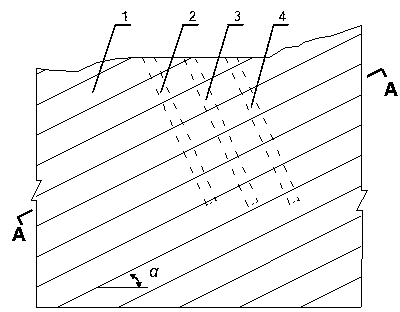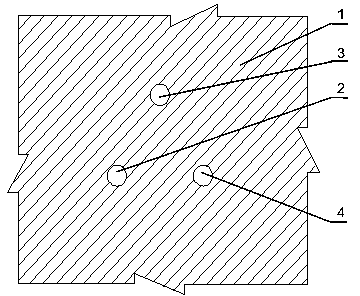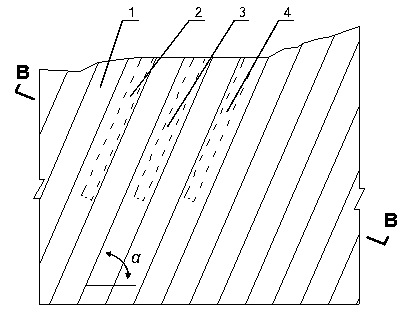Measuring method of anisotropy coefficient of transverse isotropic rock in-situ dynamic elasticity modulus
A technology of transverse isotropy and dynamic elastic modulus, applied in the analysis of solids using sonic/ultrasonic/infrasonic waves, etc., can solve the problems of inconsistent anisotropy coefficient, complexity, lack of flexible application on site, etc., to ensure accuracy, The effect of avoiding errors and avoiding obvious disturbances
- Summary
- Abstract
- Description
- Claims
- Application Information
AI Technical Summary
Problems solved by technology
Method used
Image
Examples
specific Embodiment approach
[0029] (1) Remove the surface loose rock blocks and other accumulations on the flat surface of the transversely isotropic rock mass 1 to be measured, and after identifying the isotropic surface of the transversely isotropic rock mass 1, measure it with a protractor or a compass. Determine the angle a between the isotropic plane of the transversely isotropic rock mass 1 and the horizontal plane.
[0030] (2) Mark the hole center positions of the first test hole 2, the second test hole 3 and the third test hole 4 on the flat surface of the transversely isotropic rock mass 1 to be tested. The first test hole 2, The line connecting the center points of the holes of the second test hole 3 and the third test hole 4 forms an equilateral triangle. The axes of the first test hole 2 , the second test hole 3 and the third test hole 4 are parallel to each other and two The vertical distance between the two test holes is 1.0-1.5m, which can not only ensure that the rock mass between any tw...
specific Embodiment 1
[0048] (1) Remove the surface loose rock blocks and other deposits on the flat surface of the transversely isotropic rock mass 1, which is to be measured, and identify the isotropic surface of the transversely isotropic rock mass 1, and measure it with a protractor To determine the angle between the isotropic plane and the horizontal plane of the transversely isotropic rock mass 1 is 32 degrees.
[0049] (2) Mark the hole center positions of the first test hole 2, the second test hole 3 and the third test hole 4 on the flat surface of the transversely isotropic rock mass 1 to be tested. The first test hole 2, The line connecting the center points of the holes of the second test hole 3 and the third test hole 4 forms an equilateral triangle, and the axes of the first test hole 2 , the second test hole 3 and the third test hole 4 are set to be parallel to each other. And the vertical distance between the two is 1.0 meters.
[0050] (3) Use a drilling rig to drill the first test...
specific Embodiment 2
[0056] (1) Remove the surface loose rock blocks and other accumulations on the flat surface of the transversely isotropic rock mass 1 that is intended to be measured, and after identifying the isotropic surface of the transversely isotropic rock mass 1, measure by compass It is determined that the angle between the isotropic plane of the transversely isotropic rock mass 1 and the horizontal plane is 73 degrees.
[0057] (2) Mark the hole center positions of the first test hole 2, the second test hole 3 and the third test hole 4 on the flat surface of the transversely isotropic rock mass 1 to be tested. The first test hole 2, The line connecting the center points of the holes of the second test hole 3 and the third test hole 4 forms an equilateral triangle, and the axes of the first test hole 2 , the second test hole 3 and the third test hole 4 are set to be parallel to each other. And the vertical distance between the two is 1.2 meters.
[0058] (3) The first test hole 2, the...
PUM
| Property | Measurement | Unit |
|---|---|---|
| Length | aaaaa | aaaaa |
Abstract
Description
Claims
Application Information
 Login to View More
Login to View More - Generate Ideas
- Intellectual Property
- Life Sciences
- Materials
- Tech Scout
- Unparalleled Data Quality
- Higher Quality Content
- 60% Fewer Hallucinations
Browse by: Latest US Patents, China's latest patents, Technical Efficacy Thesaurus, Application Domain, Technology Topic, Popular Technical Reports.
© 2025 PatSnap. All rights reserved.Legal|Privacy policy|Modern Slavery Act Transparency Statement|Sitemap|About US| Contact US: help@patsnap.com



